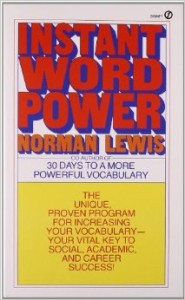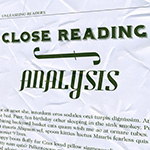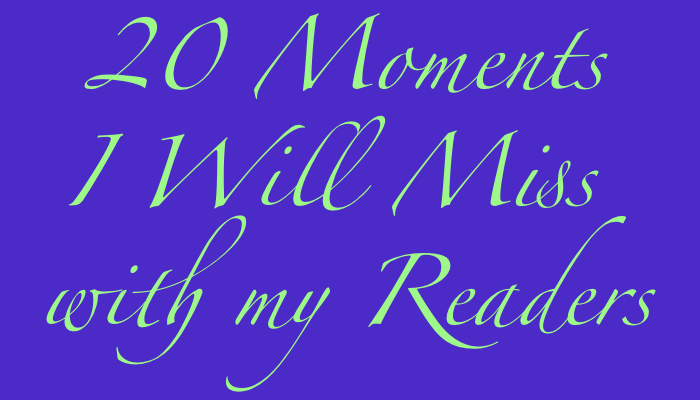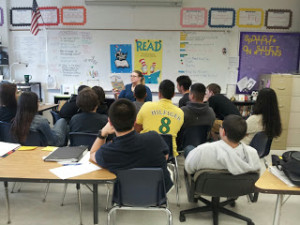
School ended over a month ago for me now, but my reflection of the school year has continued throughout the entire month. Receiving state test scores, looking over end of year surveys, and talking with students/colleagues can really get your mind going. Today, I wanted to share two of my favorite moments from the year as well as some amazing feedback I received from students. This post is not to toot my horn, but to share the amazing things that are happening because I made a choice to include independent choice reading in my classroom as well as two great moments I spent with my students.
Reflection
Independent choice reading is a huge part of my curriculum. I teach intensive reading so much of what I do teach is remedial and student-based. It saddens me when intensive teachers do not feel that another huge aspect in helping these students become better readers is just allowing them to read what they want and often. I’m not going to get into state test data, because to me that isn’t the most important data. The most important to me is did my students become better readers and learn to enjoy reading more? In short, yes. Lets first start with the numbers. This year I taught 63 students that included struggling readers as well as ESOL students who had lived in the country for less than a year when they entered our school. These 63 students read 1,017 books (that I’m aware of) in comparison to the 400ish that they said they read last year. This shows me that the time I am spending allowing them to read it worth it. Also, if I had any other questions it is feedback like this that shows me how important it is:
“At the beginning of the year I hated reading, but now I love reading.”
“I was like a bad reader, but when I got to Ms. Moye’s class everything changed.”
“My attitude [towards reading] has gotten better after the 2 years I’ve had Mrs. Moye and I feel that I’ve gotten to understand the joy of reading books and how good it is to read because it helps you and amuses you at the same time.”
“You helped me become a better reader because you made me read every day.”
“You made me read every day and pushed me to read more and become a better reader and now I read all types of books. TY.”
“You helped me to never give up on reading… and you have some really good books.”
This is why having books in my classroom, modeling reading, and have free choice reading time in my classroom is so important. Every time I have some question me about if it is worth the time, I got back to these reflections and others kids have said over the years and I know that it is the best thing for our students.
Amazing Moment- A First
This year was also a big year because I had my first skype visit with an author!!! At the end of each school year, I like to do a class novel because it builds amazing community in a classroom. As most of you probably know, I am a huge fan of apes, so this year to read with my 8th graders I chose the book Endangered by Eliot Schrefer because… well, it’s brilliant. I hoped that my students would think the same thing and they did! The book provided opportunities to discuss good author’s craft as well as a huge variety of topics. And then, as icing on the cake, Eliot Schrefer was kind enough to agree to Skype with my students. The students generated questions including asking about his decision to be an author, his experiences writing Endangered, choices he made in the book, and his future books. The students were enthralled during the skype visit and, I’ll be honest, so was I! It was like having an author in your class without the hassle of airfare, costs, etc. And don’t take my word for it:
“It gave us knowledge and understanding about what authors have to go through to write their books. Writing a book isn’t easy.”
“Eliot is engaged in a good cause and it really shows you that you don’t have to be born into something to have it, for a lack of better words, “drilled into your brain” to make it a known cause with a hopeful solution. I want to thank him for the courage to speak out on something.”
“I liked when he showed pictures of the bonobos he saw when he was in the sanctuary. I liked the bonobo he showed that was looking at the camera.”
“It was really cool that we skyped with him because it felt like he was really here with us.”
“The skype helped me understand why he made certain choices in the book like Otto’s name. It was because he had 8 fingers but also because he wanted it to be short because he was gonna put it in the book so much.”
And then lots of comments about wanting to read his next book, see Endangered as a movie, how nice he was, how cute the bonobos were, and how much they learned about the Congo.
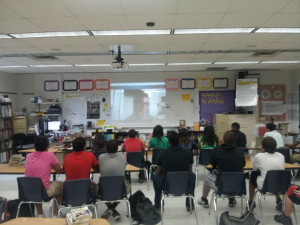
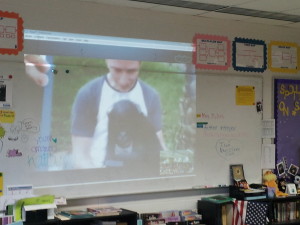
Amazing Moment- A Tradition
I’m actually doubly lucky, because Eliot is not the only author I am lucky enough to bring into my classroom. I have chosen to read Hurt Go Happy with my students 4 years now because I really feel that the novel brings to the table not only great writing, but empathy and topics that students need to be aware of and discuss. Just like every year, my students are always in love with HGH. At the end of reading, we are lucky enough to do two things to bring the book to life. First, we are lucky enough to visit the ape rescue facility Center for Great Apes in Wauchula, FL which is an actual setting in the novel. This allows the students to see chimps in as close to a natural habitat as we can get. And we also are lucky enough to talk to Ginny Rorby on the telephone. As with Eliot, the students come up with questions to ask Ginny that range from her experiences as a writer, to her feelings about chimps/animal test/child abuse/deafness, and her future plans. Here are what the students had to say about their time talking to Ginny:
“The call gave me more detail about the scenes that I didn’t get and the scenes that I disliked.”
“I learned what they do to animals in captivity like research facilities. I always thought it was just testing.”
“Ginny wrote about her life. Back then you couldn’t do much about child abuse. Or animals abuse. That part really made me mad but sad. Because why do you have to abuse kids or animals. That is just wrong.”
“I found it interesting how the people in Hurt Go Happy were named after Ginny’s relatives and friends.”
“Wow. It actually surprised me that you can put so much effort, support, detail, love, and imagination all into one book.”
“You need to know that not everyone is the same, everyone is different in their own way. You have to be proud of who you are.”
And lots more about not having animals for pet or researching on them, how nice Ginny was, how cool it was to talk to her, and how much they learned about chimps and deafness.

Do you include independent reading in your classroom?
How does it affect your students’ love of reading?
What were your best experiences this year in your classroom? Have you ever Skyped with, called, or had an author come to your school or classroom?
I cannot wait to hear about your experiences.










